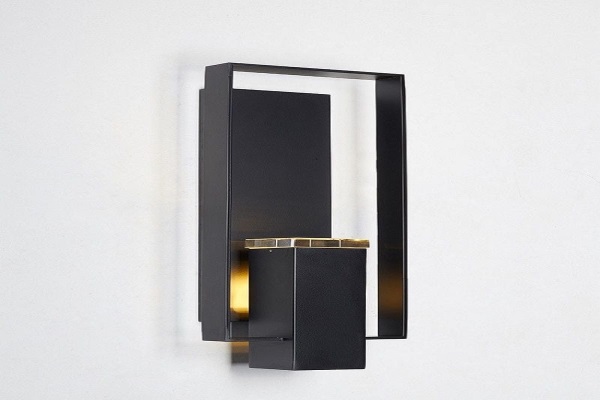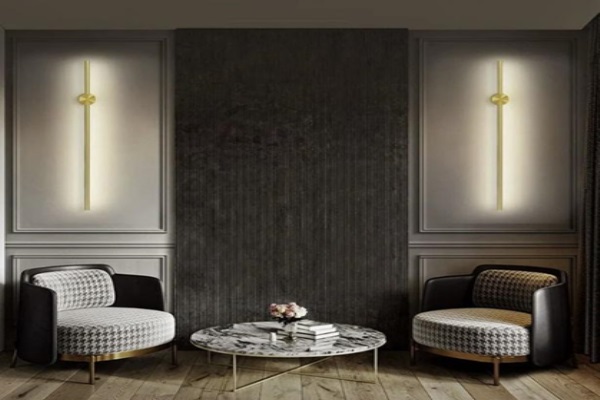Wall lights are fixtures designed to be mounted on walls to provide illumination. They are a type of lighting solution that serves functional and decorative purposes in various settings such as homes, offices, hotels, and outdoor spaces.

Wall lights come in multiple styles, shapes, and sizes, allowing them to complement different interior or exterior design themes.
Location for wall lights-
The location of wall lights depends on various factors, such as the lightig purpose, the layout of the space, and the design goals. Here are some typical locations where wall lights are often installed:
- Entryways: Wall lights near the entry door can provide a welcoming and well-lit entrance.
- Hallways: Placing wall lights along hallways ensures safe passage and adds a decorative touch.
- Living Rooms: Living room wall lights can serve as ambient or accent lighting, enhancing the overall atmosphere.
- Bedrooms: Bedside wall lights or sconces are famous for reading or creating a cosy ambience in bedrooms.
- Bathrooms: Wall-mounted fixtures, such as vanity lights, are commonly used for task lighting and grooming.
- Dining Rooms: Wall lights can complement overhead lighting in dining areas, providing additional illumination and contributing to the room’s aesthetics.
- Staircases: Step or wall lights along staircases improve safety and add a decorative element.
- Outdoor Spaces: Wall lights are often installed on the exterior walls of homes, on porches, patios, or along pathways for outdoor lighting and security.
- Artwork Display: Picture lights or wall-mounted fixtures can highlight the walls’ artwork or other decorative elements.
- Workspaces: In-home offices or study areas, wall lights can provide task lighting for work.
When installing wall lights, it’s essential to consider the fixtures’ height, spacing, and direction to achieve the desired lighting effect. Additionally, the type of wall light chosen should match with the overall design and function of the space. Always follow safety guidelines and consider hiring a professional electrician if necessary, especially for installations that involve electrical work.

Placement of wall lights-
The placement of wall lights is crucial to achieving the desired lighting effect and overall aesthetics in a space. Here are some general guidelines for the placement of wall lights:
- Eye Level: For wall lights in living rooms, hallways, or bedrooms, a standard guideline is to install them at eye level. This typically means positioning the centre of the light source at around 5 to 6 feet (1.5 to 1.8 meters) above the floor. This ensures that the light is evenly distributed and at an appropriate height for most people.
- Bedside Wall Lights: In bedrooms, wall lights or sconces should be positioned on either side of the bed so that the light is focused on the bed for reading or other activities. The lights are often installed around the headboard level.
- Mirror Placement: When installing wall lights in bathrooms or near mirrors, consider placing the fixtures on either side of the mirror rather than above. This helps minimize shadows on the face, providing more even and flattering lighting for grooming tasks.
- Artwork Illumination: Picture lights or wall-mounted fixtures used to highlight artwork should be positioned to cast light evenly on the artwork. The placement vaires on the size and shape of the art piece.
- Path Lighting: For wall lights along pathways or staircases, install fixtures at a consistent height and spacing to ensure uniform illumination and enhance safety.
- Architectural Features: When using wall lights to highlight architectural features, such as columns or textured walls, consider positioning the fixtures to accentuate the details. Experiment with various angles to achieve the desired effect.
- Functional Areas: In workspaces or reading nooks, position wall lights to provide task lighting. Adjustable wall lamps with swing arms help direct light where it’s needed.
- Spacing: Consider the spacing between multiple wall lights. The distance between fixtures will depend on the type of lighting effect you want to achieve and the intensity of the light. Spacing fixtures evenly can create a balanced and harmonious look.
Always consider the specific needs of the space, the function of the lighting, and the overall design aesthetic when determining the placement of wall lights. Additionally, if you need clarification or if the installation involves electrical work, it’s advisable to consult with a professional electrician.

Material and shape of wall lights- When it comes to wall lights, the choice of materials and shapes can significantly impact the overall beauty and functionality of the lighting fixtures.
Here’s a breakdown of considerations for both material and shape:
Material:
- Metal: Common materials for wall lights include metals such as stainless steel, brass, copper, or wrought iron. Metal finishes can range from polished to brushed, providing different looks from contemporary to traditional.
- Glass: Glass is often used for lampshades or covers, contributing to a sleek and stylish appearance. Frosted or coloured glass can influence the quality and diffusion of light.
- Ceramic: Ceramic wall lights can add a touch of craftsmanship and uniqueness. They can be painted or textured, allowing for various design possibilities.
- Wood: Wooden wall lights can introduce a warm and natural element to a space. They are often used in rustic or Scandinavian-inspired designs.
- Plastic or Acrylic: Some wall lights feature plastic or acrylic components for more budget-friendly options. These materials are versatile and can be moulded into various shapes.
- Fabric: Fabric shades or covers can soften the light emitted by wall fixtures, creating a cosy and inviting atmosphere. Common in sconces and wall lamps.
- Stone: Natural stone, like marble or slate, can be used for wall light fixtures, adding a touch of luxury and uniqueness.
Shape:
- Sconces: Sconces come in various shapes, from classic torch designs to more modern and abstract shapes. The shape can influence the direction and distribution of light.
- Cylindrical: Cylindrical wall lights provide a sleek and contemporary look. They are often used for ambient or accent lighting.
- Geometric: Modern wall lights may feature geometric shapes such as cubes, rectangles, or hexagons. These shapes can add a sense of sophistication and contemporary style.
- Traditional: Traditional wall lights may have more ornate or classic shapes, such as scrolls, curves, or floral motifs, fitting well with conventional or vintage decor.
- Adjustable: Wall lights with flexible arms or swivels allow for flexibility in directing light. These are often used for task lighting in reading areas or home offices.
- Abstract or Artistic: Some wall lights serve as artistic focal points with abstract or unique shapes. These can be conversation starters and add a touch of creativity to the space.
- Minimalistic: Minimalist designs often feature clean lines and simple shapes, contributing to a sense of understated elegance.
When selecting wall lights, consider the overall design theme of the space, the intended function of the lighting, and how the materials and shapes will complement the existing decor. It’s also essential to ensure the chosen materials are suitable for the environment, especially for outdoor wall lights.
Lighting Effect-
The choice of wall lights plays a significant role in creating different lighting effects within a space. Here are several lighting effects that can be achieved using wall lights:
- Ambient Lighting:
Sconces and Wall Lamps: Wall lights with opaque or diffused shades can provide soft, ambient lighting. The fixtures are typically mounted at eye level, casting light in all directions and creating a comfortable atmosphere.
- Accent Lighting:
Picture Lights: Used to highlight artwork or photographs on walls, picture lights focus a narrow beam of light on the subject, creating a striking visual impact.
- Task Lighting:
Adjustable Wall Lamps: Wall-mounted fixtures with adjustable arms are suitable for task lighting in reading nooks or home offices. They allow users to direct light precisely where it’s needed.
- Up-Lighting and Down-Lighting:
Up and Downlights: These fixtures emit light upwards and downwards, creating a beautiful effect on the wall. They can highlight architectural features or provide general illumination.
- Decorative Patterns:
Artistic or Geometric Shapes: Wall lights with unique shapes or patterns can create visually exciting effects on the wall when illuminated. This is especially effective when the light fixture itself becomes a decorative element.
- Shadow Play:
Textured or Patterned Shades: Wall lights with textured or patterned shades can cast intricate shadows on the wall when illuminated, adding depth and visual interest to the space.
- Wall Washing:
Recessed Wall Lights: These fixtures are installed within the wall and can “wash” the wall with light, providing a subtle and even illumination across a larger surface.
- Grazing:
Wall Grazing Lights: Placed close to a textured surface, such as a stone or brick wall, these lights create a grazing effect that enhances the texture and highlights the surface details.
- Focal Point Illumination:
Statement Wall Lights: Bold or unique wall light fixtures can serve as focal points for a home, drawing attention and contributing to the overall design
- Outdoor Ambiance:
Bulkhead Lights: These sturdy fixtures often provide functional and ambient lighting outdoors. They can contribute to the overall ambience of outdoor spaces.
When planning the lighting design for a space, it’s common to use a combination of these effects to achieve a well-balanced and visually appealing result. Consider the purpose of the lighting, the mood you want to create, and how different wall lights can work together to achieve the desired effects in other areas of a room or outdoor space.
To know about lighting Dubai, please visit our website: mafeemushkil.com
You may also like
-
Effective Garage Door Maintenance Routines That Reduce Long-Term Repair Expenses
-
Interior Rendering Features in Monthly Showcase Portfolios: Realism, Ray Tracing, Faster Updates
-
Step-by-Step Plan Tips for Selling House without Stress
-
Best Options for Shipping Containers in Bozeman
-
Design & Function: A Guide to Choosing the Right Style of Glass for Your Office Partitions
